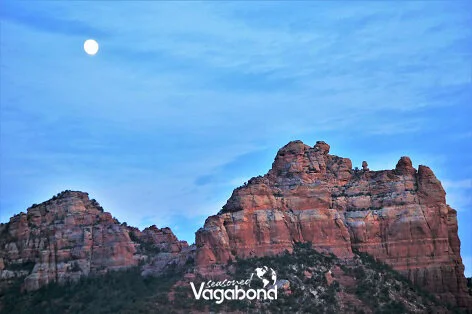
Sedona
Grandeur and Peace Amidst the Red Rocks
From the overlook above Sedona, the full moon cast stark shadows on the slick rock while Orion rose tall over Cathedral Rock to the southeast. The high desert night was bright—and aromatic.
- Seasoned Vagabond -
To my family,
lingering at an overlook under the moon and stars didn’t make sense. An evening in the hotel pool followed by an in-room movie was more their style. Therein lies the seduction of Sedona. “If you can’t find what you like here,” a local saying goes, “then you haven’t made up your mind what you want.”
The striking red rock country
circling Sedona has lured people for centuries. Guarded by the Mogollon Rim and surrounded by fanciful spires of red sandstone, Sedona is a serene, inspiring marriage of mountains and desert. To the Anasazi Indians who settled here around 1000 A.D., this was sacred ground. To the scores of resident painters, writers, sculptors and other artists, Sedona is a magnet of regeneration and creativity.
Besides its pervasive physical beauty, Sedona enjoys a reputation as a place where energy emanates from special sites called “vortexes.” The writer Page Bryant first used the term “vortex” in 1980 to describe Sedona’s four renowned energy sites: Bell Rock, Cathedral Rock, Airport Mesa and Boynton Canyon. These vortexes are spiritual, magical, extraterrestrial, geological or just plain fictional—depending on who offers the description.
Whether it’s a spiritual phenomenon or just some outlandishly beautiful scenery, Sedona has a strong pull for seekers of many sorts.
In other words, Sedona can be appreciated for its physical beauty alone. You could also appreciate the area for the mental stimulation to be had when so many artisans and intellectuals gather in one spot. Then there is the distinct possibility of emotional revitalization and relaxation as a result of time spent here. And, for some, there is an elevated awareness or a spiritual shift in values experienced amidst the red rocks. However your choose to experience Sedona is the right way. For our family, this meant getting outdoors. We hiked, biked, rode horses and took a jeep tour in the back country. For others, there’s plenty to do at the luxurious resorts, upscale shops and golf courses.
Culturally, Sedona is as diverse
as the people it attracts. Festivals abound, focusing on art, crafts, film, photography, music and more. Stir in an eclectic mix of special events, including running, yoga, history, nutrition, health and entertainment, and you’ll find a fun menu of activities year-round.
All of this reflects the potpourri of people who play and live here. There is a delightful melange of cowboys, artists, psychics, past-life acupuncturists, retirees and nature lovers who call the place home. The 10,000 plus residents welcome over 3 million visitors each year who come for the natural beauty as well as for the art galleries and spas.
When we wanted to escape the t-shirt shops and downtown hubbub, we simply drove out of town. Sedona is surrounded by the 1.8 million-acre Coconino National Forest and over 300 miles of trails. An early morning hike in the Munds Mountain Wilderness, just southeast of Sedona, was a family favorite. We scrambled through junipers and prickly pear below crimson rock spires. To the west, a fading full moon slipped to the horizon while the rising sun ignited the formations towering like sentinels above the town. The spires and buttes have acquired names that reflect their shape: Bell, Coffee Pot, Snoopy, Submarine, Elephant. You can visit them on foot, two wheels, four wheels, horseback, hot-air balloon or helicopter.
Hollywood has taken note of the area’s scenic grandeur, too. More than 90 westerns have been filmed around Sedona and the red rock country. Movie stars such as John Wayne, Jimmy Stewart, Henry Fonda and Robert DeNiro rode horseback through the same scenery as did our family.
While riding horses was a gentle way to be part of the landscape,
mountain bike riding the next day was all action. Though more extreme trails exist, our family enjoyed the network of easy to moderate trails that skirted the base of Bell Rock and Court House Rock. We also experienced the back country on a jeep tour. Guides focus on geology, history or spirituality, depending on visitor taste. Our guide (from Pink Jeep Tours on our latest visit) had a background in geology, writing and counseling. He was happy to tailor his comments to our interests while bumping over boulders on the steep trails. When asked for his take on the vortex scene, he was tactful and articulate. “You get what you need. For some, it’s the chance to be close to amazing natural beauty. For others, it’s a thirst to find a spiritual home—a willingness to be available for whatever lesson comes their way. Few leave without being inspired.”
On both of our Sedona visits, we treated ourselves to a drive up Oak Creek Canyon toward Flagstaff on Arizona Highway 89A. On the first excursion, two middle school children in tow, we pulled into Slide Rock State Park. The park preserves the Pendley Homestead, a 43-acre historic apple farm. Though the homestead held our kids’ interest for maybe 5 minutes, their goal was the famous Slide Rock.
Slide Rock is a stretch of of slippery creek bottom that serves as a natural water slide. We had a grand time running the rocky chute on our bottoms. That was then. When my wife and I drove this curvy, climbing route last year minus kids, we were content to vicariously enjoy the antics of other families splashing and sliding in Oak Creek.
Looking back on both Sedona jaunts, the land and how we related to it were all that really mattered. We’re still not sure if the vortexes are real or not. We definitely left Sedona both relaxed and revitalize. And that was enough.









IF YOU GO:
For all things Sedona, go to: www.visitsedona.com
Sedona is about 110 miles north of Phoenix and 25 miles south of Flagstaff. If driving from Phoenix, take Interstate Highway 17 north for about an hour, then exit onto Arizona Highway 179 north to Sedona. From Flagstaff, drive south on Arizona Highway 89A to Sedona.





